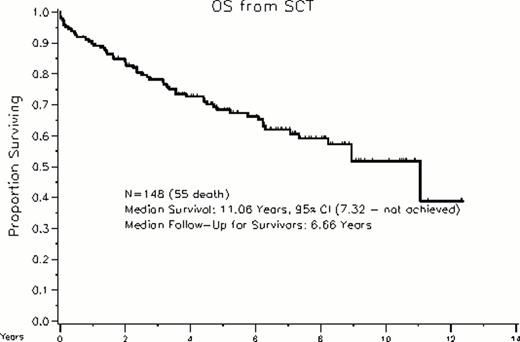Abstract
High dose melphalan (MEL) is a standard treatment for eligible patients with AL, a disease in which hematologic response is a key determinant of survival. With the advent of novel agents the role of stem cell transplant (SCT) for patients with AL is being questioned, especially given safety concerns. Yet with appropriate patient selection and the use of risk-adapted SCT (RA-SCT), treatment-related mortality (TRM) improved.(Br J Haem 2007;139:224; Bone Marrow Transplantation 2011; 46:970) Moreover, beginning in 2002, we showed in 2 consecutive phase II trials that following RA-SCT patients can safely receive consolidation with thalidomide and dexamethasone (TD) or bortezomib and D (BD), with the goal of improving hematologic response thereby extending overall survival (OS).(Br J Haem 2007;139:224; Amyloid 2010;17:80a) Consolidation was administered for patients achieving less than a complete response (CR). We now describe the outcomes of all patients with AL who underwent RA-SCT at Memorial Sloan-Kettering Cancer Center (MSKCC) since the year 2000.
We performed a retrospective study to assess the OS of all patients who underwent SCT for a diagnosis of AL confirmed at MSKCC. Patients who had >2 major organs involved, NYHA class III or greater CHF, critical arrhythmias or cardiac syncope were ineligible for SCT. OS was calculated from transplant to date of death or last follow up. Median survival was estimated by Kaplan Meier methods. Log-rank test was used to determine whether survival functions differed by covariates of interest. Cumulative incidence function was used to estimate the incidence of cause-specific mortality.
A total of 151 patients underwent RA-SCT between February 2000 and June 2011; three lost to follow-up are excluded from this analysis. Of the remaining 148 patients 21%, 52% and 34% received RA-SCT at 100, 140 and 200mg/m2 of melphalan respectively based on age, renal function and cardiac involvement.(Blood 2002; 99: 4276) Five patients died within 100 days of SCT (TRM 3.4%). At a median follow up of 6.7 years, the median OS for all patients is 11.1 years (95% CI, 7.32 - not reached-NR) (Figure 1), and for patients who received MEL 100, 140 or 200 is 4.4 (95% CI, 2.7 – 6.3), NR and 11 years (95% CI, 8.2 – NR) respectively (P = <0.01). Cumulative incidence of disease related mortality at 2 years is 5.5%, and subsequently the rate of death from other causes exceeds that due to AL (Figure 2).
RA-SCT for appropriately selected patients is safe and is associated with excellent long-term survival. Consolidation with novel agents may improve survival following RA-SCT and likely accounts for the similar OS seen in patients who received MEL 140 and 200. In the era of novel agents available for post-SCT consolidation, RA-SCT is an effective and important initial treatment for patients with AL.
Landau:Millenium: Membership on an entity's Board of Directors or advisory committees, Research Funding; Onyx: Research Funding. Hassoun:Millenium: Membership on an entity's Board of Directors or advisory committees, Research Funding; Celgene: Research Funding. Giralt:Millenium: Membership on an entity's Board of Directors or advisory committees; Celgene: Membership on an entity's Board of Directors or advisory committees, Research Funding; Onyx: Membership on an entity's Board of Directors or advisory committees, Research Funding. Comenzo:Millenium: Membership on an entity's Board of Directors or advisory committees, Research Funding.

This icon denotes a clinically relevant abstract
Author notes
Asterisk with author names denotes non-ASH members.



This feature is available to Subscribers Only
Sign In or Create an Account Close Modal